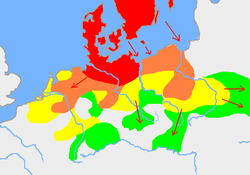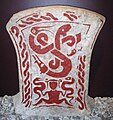Iron Age Scandinavia
Appearance
Nordic Iron Age and Jastorf cultures

Settlements before 750 BC
New settlements by 500 BC
New settlements by 250 BC
New settlements by AD 1
Some sources also give a date of 750 BC for the earliest expansion out of southern Scandinavia and northern Germany along the North Sea coast towards the mouth of the Rhine.[2]Iron Age Scandinavia (or Nordic Iron Age) was the Iron Age, as it unfolded in Scandinavia. It was preceded by the Nordic Bronze Age.
Beginnings
The 6th and 5th centuries BC were a tipping point for exports and imports on the European continent. The ever-increasing conflicts and wars between the central European
oppida, and the more stable political situation in Europe allowed for a whole new economic development and trade.[3]
wood pastures, but were now placed in stables, probably to utilize manure more efficiently and increase agricultural production. Even though the advent of the Iron Age in Scandinavia was a time of great crisis, the new agricultural expansions, techniques and organizations proceeded apace. And though the decline of foreign trade might suggest that the period marked a transition from a rich and wealthy culture to a poor and meagre one, the population grew and new technology was developed. The period might just reflect a change of culture and not necessarily a decline in standards of living.[3]
Periodization
The Iron Age in Scandinavia and
Hallstatt D/La Tène
cultures.
- bog bodies from Danish bog areas, some ritually killed, perhaps as human sacrifices, of which Tollund Man (found 1950) is the best-known. Their hair, skin and possessions have often been preserved in the anaerobic conditions, allowing archaeologists to learn more about their lifestyle.[5]
- Roman Iron Age(1st to 4th centuries AD)
- Germanic Iron Age(5th to 8th centuries AD)
- Vendel era
The Northern European Iron Age is the locus of
Istvaeonic
) in northern Germany.
Culture and religion
| Nordic Iron Age culture | |
|---|---|
| |
| |
| |
| Nordic Iron Age cult | |
|---|---|
| |
| |
| |
See also
- British Iron Age
- Germanic Wars
- Migration period
- Proto-Germanic
- Proto-Norse
References
- ISBN 0-14-051054-0.
- ISBN 0-85229-571-5.
- ^ a b Jørgen Jensen: I begyndelsen
- ^ Bailey, Stephanie (26 February 2019). "Climate change reveals, and threatens, thawing relics". CNN. Archived from the original on 26 February 2019. Retrieved 25 March 2020.
- ^ "Ancient Europe 8000 B.C-1000 A.D" (PDF). Archived from the original (PDF) on 9 January 2016. Retrieved 9 November 2018.
- ^ "Hodde Iron Age village". danmarksoldtid.lex.dk. Archived from the original on 1 August 2023. Retrieved 7 August 2023.
- ^ "Veien Kulturminnepark". Archived from the original on 26 May 2022. Retrieved 30 April 2022.
Sources
- Jørgen Jensen (2002): I begyndelsen, Gyldendal og Politikens Danmarks Historie (Vol. 1), ISBN 87-89068-26-2(in Danish)
- Bente Magnus, G Franceschi, Asger Jorn (2005): Men, Gods and Masks in Nordic Iron Age Art. OCLC 84747032.
- M Zvelebil (1985): Iron Age transformations in Northern Russia and the Northeast Baltic, Beyond Domestication in Prehistoric Europe
External links
 Media related to Nordic Iron Age at Wikimedia Commons
Media related to Nordic Iron Age at Wikimedia Commons- The Vendel Period: The Golden Age of the Norse

![Model of Hodde Iron Age village, Denmark, c. 100 BC.[6]](http://upload.wikimedia.org/wikipedia/commons/thumb/0/05/Hodde_Iron_Age_village%2C_Denmark%2C_c._100_BC.png/120px-Hodde_Iron_Age_village%2C_Denmark%2C_c._100_BC.png)
![Reconstructed Iron Age hall at Veien, Norway. Roman Iron Age, 1st-2nd century AD.[7]](http://upload.wikimedia.org/wikipedia/commons/thumb/d/da/Langhuset_Veien_kulturminnepark_20070722.JPG/120px-Langhuset_Veien_kulturminnepark_20070722.JPG)


















